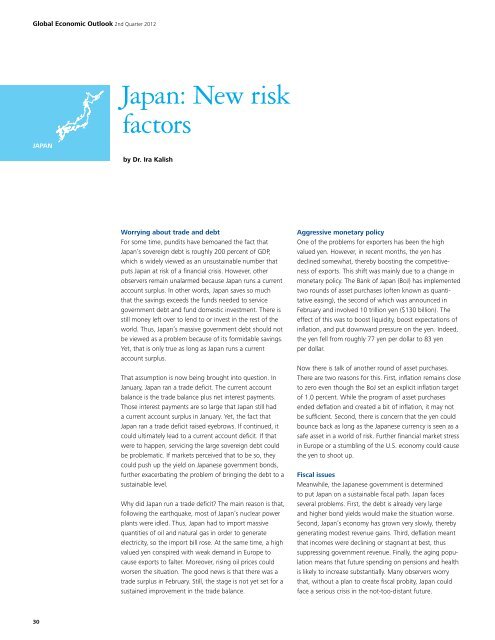Create successful ePaper yourself
Turn your PDF publications into a flip-book with our unique Google optimized e-Paper software.
Global Economic Outlook 2nd Quarter 2012<br />
JAPAN<br />
30<br />
Japan: New risk<br />
factors<br />
by Dr. Ira Kalish<br />
Worrying about trade and debt<br />
For some time, pundits have bemoaned the fact that<br />
Japan’s sovereign debt is roughly 200 percent <strong>of</strong> GDP,<br />
which is widely viewed as an unsustainable number that<br />
puts Japan at risk <strong>of</strong> a financial crisis. However, other<br />
observers remain unalarmed because Japan runs a current<br />
account surplus. In other words, Japan saves so much<br />
that the savings exceeds the funds needed to service<br />
government debt and fund domestic investment. There is<br />
still money left over to lend to or invest in the rest <strong>of</strong> the<br />
world. Thus, Japan’s massive government debt should not<br />
be viewed as a problem because <strong>of</strong> its formidable savings.<br />
Yet, that is only true as long as Japan runs a current<br />
account surplus.<br />
That assumption is now being brought into question. In<br />
January, Japan ran a trade deficit. The current account<br />
balance is the trade balance plus net interest payments.<br />
Those interest payments are so large that Japan still had<br />
a current account surplus in January. Yet, the fact that<br />
Japan ran a trade deficit raised eyebrows. If continued, it<br />
could ultimately lead to a current account deficit. If that<br />
were to happen, servicing the large sovereign debt could<br />
be problematic. If markets perceived that to be so, they<br />
could push up the yield on Japanese government bonds,<br />
further exacerbating the problem <strong>of</strong> bringing the debt to a<br />
sustainable level.<br />
Why did Japan run a trade deficit? The main reason is that,<br />
following the earthquake, most <strong>of</strong> Japan’s nuclear power<br />
plants were idled. Thus, Japan had to import massive<br />
quantities <strong>of</strong> oil and natural gas in order to generate<br />
electricity, so the import bill rose. At the same time, a high<br />
valued yen conspired with weak demand in Europe to<br />
cause exports to falter. Moreover, rising oil prices could<br />
worsen the situation. The good news is that there was a<br />
trade surplus in February. Still, the stage is not yet set for a<br />
sustained improvement in the trade balance.<br />
Aggressive monetary policy<br />
One <strong>of</strong> the problems for exporters has been the high<br />
valued yen. However, in recent months, the yen has<br />
declined somewhat, thereby boosting the competitiveness<br />
<strong>of</strong> exports. This shift was mainly due to a change in<br />
monetary policy. The Bank <strong>of</strong> Japan (BoJ) has implemented<br />
two rounds <strong>of</strong> asset purchases (<strong>of</strong>ten known as quantitative<br />
easing), the second <strong>of</strong> which was announced in<br />
February and involved 10 trillion yen ($130 billion). The<br />
effect <strong>of</strong> this was to boost liquidity, boost expectations <strong>of</strong><br />
inflation, and put downward pressure on the yen. Indeed,<br />
the yen fell from roughly 77 yen per dollar to 83 yen<br />
per dollar.<br />
Now there is talk <strong>of</strong> another round <strong>of</strong> asset purchases.<br />
There are two reasons for this. First, inflation remains close<br />
to zero even though the BoJ set an explicit inflation target<br />
<strong>of</strong> 1.0 percent. While the program <strong>of</strong> asset purchases<br />
ended deflation and created a bit <strong>of</strong> inflation, it may not<br />
be sufficient. Second, there is concern that the yen could<br />
bounce back as long as the Japanese currency is seen as a<br />
safe asset in a world <strong>of</strong> risk. Further financial market stress<br />
in Europe or a stumbling <strong>of</strong> the U.S. economy could cause<br />
the yen to shoot up.<br />
Fiscal issues<br />
Meanwhile, the Japanese government is determined<br />
to put Japan on a sustainable fiscal path. Japan faces<br />
several problems. First, the debt is already very large<br />
and higher bond yields would make the situation worse.<br />
Second, Japan’s economy has grown very slowly, thereby<br />
generating modest revenue gains. Third, deflation meant<br />
that incomes were declining or stagnant at best, thus<br />
suppressing government revenue. Finally, the aging population<br />
means that future spending on pensions and health<br />
is likely to increase substantially. Many observers worry<br />
that, without a plan to create fiscal probity, Japan could<br />
face a serious crisis in the not-too-distant future.











